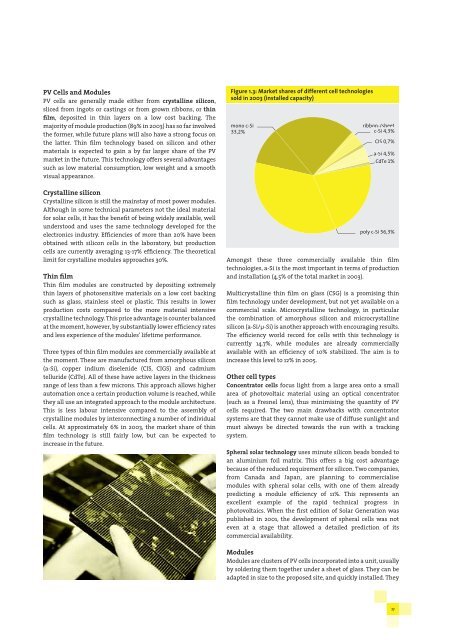SOLAR GENERATION - Greenpeace
SOLAR GENERATION - Greenpeace
SOLAR GENERATION - Greenpeace
You also want an ePaper? Increase the reach of your titles
YUMPU automatically turns print PDFs into web optimized ePapers that Google loves.
PV Cells and Modules<br />
PV cells are generally made either from crystalline silicon,<br />
sliced from ingots or castings or from grown ribbons, or thin<br />
film, deposited in thin layers on a low cost backing. The<br />
majority of module production (89% in 2003) has so far involved<br />
the former, while future plans will also have a strong focus on<br />
the latter. Thin film technology based on silicon and other<br />
materials is expected to gain a by far larger share of the PV<br />
market in the future. This technology offers several advantages<br />
such as low material consumption, low weight and a smooth<br />
visual appearance.<br />
Crystalline silicon<br />
Crystalline silicon is still the mainstay of most power modules.<br />
Although in some technical parameters not the ideal material<br />
for solar cells, it has the benefit of being widely available, well<br />
understood and uses the same technology developed for the<br />
electronics industry. Efficiencies of more than 20% have been<br />
obtained with silicon cells in the laboratory, but production<br />
cells are currently averaging 13-17% efficiency. The theoretical<br />
limit for crystalline modules approaches 30%.<br />
Thin film<br />
Thin film modules are constructed by depositing extremely<br />
thin layers of photosensitive materials on a low cost backing<br />
such as glass, stainless steel or plastic. This results in lower<br />
production costs compared to the more material intensive<br />
crystalline technology. This price advantage is counter balanced<br />
at the moment, however, by substantially lower efficiency rates<br />
and less experience of the modules’ lifetime performance.<br />
Three types of thin film modules are commercially available at<br />
the moment. These are manufactured from amorphous silicon<br />
(a-Si), copper indium diselenide (CIS, CIGS) and cadmium<br />
telluride (CdTe). All of these have active layers in the thickness<br />
range of less than a few microns. This approach allows higher<br />
automation once a certain production volume is reached, while<br />
they all use an integrated approach to the module architecture.<br />
This is less labour intensive compared to the assembly of<br />
crystalline modules by interconnecting a number of individual<br />
cells. At approximately 6% in 2003, the market share of thin<br />
film technology is still fairly low, but can be expected to<br />
increase in the future.<br />
Figure 1.3: Market shares of different cell technologies<br />
sold in 2003 (installed capacity)<br />
mono c-Si<br />
33,2%<br />
ribbon-/sheet<br />
c-Si 4,3%<br />
CIS 0,7%<br />
a-Si 4,5%<br />
CdTe 1%<br />
poly c-Si 56,3%<br />
Amongst these three commercially available thin film<br />
technologies, a-Si is the most important in terms of production<br />
and installation (4.5% of the total market in 2003).<br />
Multicrystalline thin film on glass (CSG) is a promising thin<br />
film technology under development, but not yet available on a<br />
commercial scale. Microcrystalline technology, in particular<br />
the combination of amorphous silicon and microcrystalline<br />
silicon (a-Si/µ-Si) is another approach with encouraging results.<br />
The efficiency world record for cells with this technology is<br />
currently 14.7%, while modules are already commercially<br />
available with an efficiency of 10% stabilized. The aim is to<br />
increase this level to 12% in 2005.<br />
Other cell types<br />
Concentrator cells focus light from a large area onto a small<br />
area of photovoltaic material using an optical concentrator<br />
(such as a Fresnel lens), thus minimising the quantity of PV<br />
cells required. The two main drawbacks with concentrator<br />
systems are that they cannot make use of diffuse sunlight and<br />
must always be directed towards the sun with a tracking<br />
system.<br />
Spheral solar technology uses minute silicon beads bonded to<br />
an aluminium foil matrix. This offers a big cost advantage<br />
because of the reduced requirement for silicon. Two companies,<br />
from Canada and Japan, are planning to commercialise<br />
modules with spheral solar cells, with one of them already<br />
predicting a module efficiency of 11%. This represents an<br />
excellent example of the rapid technical progress in<br />
photovoltaics. When the first edition of Solar Generation was<br />
published in 2001, the development of spheral cells was not<br />
even at a stage that allowed a detailed prediction of its<br />
commercial availability.<br />
Modules<br />
Modules are clusters of PV cells incorporated into a unit, usually<br />
by soldering them together under a sheet of glass. They can be<br />
adapted in size to the proposed site, and quickly installed. They<br />
11

















